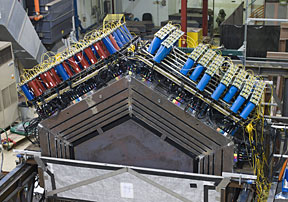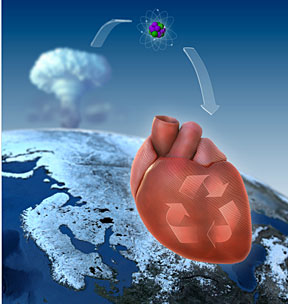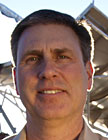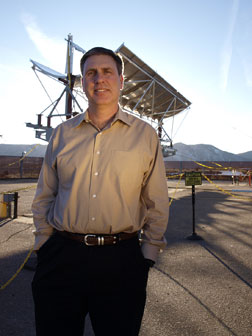Research
Highlights...
|
 |
Number 284 |
April 13, 2009 |
|
Corrosion-resistant nano-coating for metals
 |
The aluminum fin at left had no protective coating and completely dissolved after repeated exposure to briny conditions. The middle fin had a coating with a low level of cerium oxide nanoparticles, while the far right fin had a higher concentration of nanoparticles. |
A chemist at DOE's Brookhaven Lab has developed a method for coating metal surfaces with an ultrathin nanoparticle film that renders the metal resistant to corrosion and eliminates the use of toxic chromium. The method yields a coating less than 10 nanometers thick with corrosion resistance comparable or superior to chromium-based coatings with better surface coverage—particularly advantageous when the metal to be coated possesses fine structural detail. The newly patented method, which is available for licensing, should be of specific interest to industries that produce coated valves, pumps, and other components exposed to wet or briny conditions.
[Karen McNulty Walsh, 631.344.8350,
kmcnulty@bnl.gov] |
|
MINERvA sees first neutrinos
 |
The first portion of the MINERvA neutrino detector |
A new neutrino detector under construction at DOE’s Fermi National Accelerator Laboratory just got its first glimpse at how the elusive particle interacts with matter. On April 1, the first portion of the MINERvA detector, comprised of 24 modules, observed its first neutrinos. When the detector is fully assembled in 2010, it will have 108 modules, each about two inches thick. Using a high-intensity beam of neutrinos provided by the Fermilab accelerator complex, the MINERvA collaboration will study low-energy neutrino interactions, including the strong dynamics of the nucleon and nucleus that affects these interactions. “This is a huge milestone for us,” said MINERvA cospokesperson Kevin McFarland, of the University of Rochester.
[Kurt Riesselmann, 630.840.3351,
kurtr@fnal.gov] |
|
Conversions make safer research reactors
Nuclear reactors on university campuses enable nuclear materials research and help train the next generation of nuclear engineers. But many campus reactors run on highly enriched uranium (HEU). DOE's Idaho National Laboratory is helping change that by leading part of a U.S. National Nuclear Security Administration (NNSA) nuclear nonproliferation mission. Research reactors at Washington State and Oregon State universities were recently converted to use low enriched uranium (LEU) fuel rather than HEU. Research reactor conversions were also completed at Purdue University in September 2007 and at Texas A&M and the University of Florida in September 2006. INL project managers coordinate all of the conversion activities including the conversion analyses, the LEU fuel fabrication, core loading and restart of the reactor.
[Ethan Huffman, 208.526.5955,
ethan.huffman@inl.gov]
|
X-rays reveal flu virus traits
New findings from research performed on the influenza virus using X-rays generated by the Advanced Photon Source at DOE's Argonne National Laboratory may help pave the way for the development of a new, more effective vaccine that could combat a wide range of strains of the common and frequently deadly illness. A group from the Scripps Research Institute in California used X-rays provided by the APS's National Institute of General Medical Sciences/National Cancer Institute Collaborative-Access Team (GM/CA-CAT) beamline to examine structures of the viral protein hemagluttinin from different strains of the virus. The researchers showed that a recently isolated, broadly neutralizing antibody bound to a conserved helical part of the "stalk" region of hemagluttinins from different strains of the virus. This result could allow researchers to tailor vaccines that would allow immunized patients to produce antibodies that would bind to the largely shared "stalk" regions of different viruses' hemagluttinin. Once the antibody binds to the stalk, the virus cannot change its conformation and infect the cell.
[Jared Sagoff, 630.252.5549,
jsagoff@anl.gov] |
|
|
Kutscher noted for passion to
reduce carbon footprint
|
Chuck Kutscher leads concentrating solar power research using NREL’s Large Payload Solar Tracker.
|
When you have the opportunity to spend 30 years working in a field you love, some might be worried about losing their zeal, but Chuck Kutscher of DOE's National Renewable Energy Laboratory is a shining example of someone who continues to find new passions along the way.
Recently Kutscher was recognized by Colorado’s Gov. Bill Ritter with the 2nd Annual Governor’s Excellence in Renewable Energy, Individual Award, which honors outstanding contributions to protect Colorado’s environment and provide clean power through renewable energy.
Kutscher is currently a principal engineer and group manager of the Thermal Systems Group in NREL’s Center for Electricity, Resources and Systems Integration where he is taking the lead on concentrating solar power research. However, it’s what Kutscher has been doing outside of the office that’s also earned the attention of the Governor.
“I developed a passion for the climate change issue while serving as the American Solar Energy Society chair back in 2000 and 2001,” said Kutscher. “The more I studied the science, the more I became convinced that it is a much more serious problem than most Americans realize.”
In preparation for the 2006 National Solar Energy Conference, Kutscher brought together a cross-section of energy experts— many of them NREL colleagues who volunteered their time—to publish a 200-page report, “Tackling Climate Change in the U.S. —Potential Carbon Emissions Reductions from Energy Efficiency and Renewable Energy by 2030.” The study shows that energy efficiency measures can halt the rise in U.S. carbon emissions and renewable technologies can provide the large cuts that will be needed.
“Energy efficiency and renewable energy technologies have tremendous capacity to reduce the U.S. carbon footprint,” Kutscher said. “Many of those technologies are ready now, while continued R&D will improve performance and lower costs, we can’t afford to wait to deploy them.”
Energized by what the future holds, Kutscher has been invited to speak at numerous upcoming events, but his NREL work is foremost on his mind, “I will continue to work on applications for concentrating solar power and will continue to look for ways that energy efficiency and renewable energy can address the problem of climate change.” – Heather Lammers
Submitted by DOE's National Renewable Energy Laboratory
|
|





